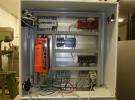(sorry for my english skills, I'm a german student trying my best)
Dear Community,
as you can already imagine, "I have no idea what am I doing" :-)
Ok, that's not 100% true.. I desperately try to figure out, how to connect 4 pot sensors to my T7.
Background:
I started a study project to measure movements of a vertical steal tube.
Therefore my boss allowed me to buy a T7 Pro, a terminal block CB37and 4 pots with a cable length of 10 meters each.
So here I am :)
So I know basic electrical engineering "stuff" and I'm pretty eager to find things myself, but I stuck.
The thing is, the pots are new and pretty expensive (at least of a sight of a student...).
So I'm afraid to accidentally overload the pots and with this crash my whole project.
Sensors: (RC20 IP60 - Megatron)
- Potentiometer
- 1000 Ohm
- Max. load 0.8 W
- Max supply Voltage 20 V
- Maximal deployable current on slide >2 mA
I just don't get, how to wire all sensors on the terminal board.
It heavily frustrates me, that I can't find nowhere a tutorial how to wire more than one sensor up.
Can someone please give me a hint or a short instruction, how to do this?
I'm very afraid of doing something wrong, these devices are very expensive and I won't ruin them and my studies..
Kind regards,
Jaques



.png%3Fitok=PHGBxf6M)


.jpg%3Fitok=B1YcuDFK)
.png%3Fitok=Ybt-OlgU)
A pot is a voltage divider such as is shown in Figure 1 here:
https://labjack.com/support/app-notes/measuring-resistance
You connect some excitation voltage across the pot, and the signal wire gives you a voltage signal. So you connect Vexc and GND across each pot, and connect each signal wire to an analog input.
So what to use for Vexc? You can use VS (~5 volts), but it is a power supply not a reference so has substantial noise and variance. You could use 1 or both of the DAC outputs, and it will give you a much more stable and low-noise excitation, but you want to use feedback to measure the actual value of your exciation in real time. The best choice would be an LJTick-Vref-41.
Hi,
Thank you for replying.
Yes, got it. But with every answer, new questions pop up...
Please see attached my rookie attempt to display it into a circuit diagram.
Question 1:
So the pots are in parallel.
What is the highest current which could "happen" to one of the pots?
Or in other words, what is the highest current DAC0 could supply?
Please be aware, every single pot is only capable of withstanding >2 mA.
So with:
I = U / (R1 + R2) (R1 + R2 ) = 1000 Ohm
U = 1.8 mA * 1000 Ohm Limiting I to 1.8 mA to fulfill the req. for Imax of each pot (worst case, whole Imax runs through one pot)
I obtain for U = 1.8 V
When deploying 1.8 V on DAC0, I fulfill every requirement, do I?
Is there something I forgot which potentially can crash my sensors?
Question 2:
When using the LJTick-Resistance device, then there is a probability to exceed the maximum current of 1.8 mA?
Vref: Maximum output current: 10 mA
10 mA > 2 mA maximum allowed current
Is there a possibility of limiting the maximum current for this constant voltage source?
Question 3:
Is there a plug-in module for bundling the four + sides to DAC0 (or LJTick Resistance)?
Or just clamp all four cables into one terminal?
Sorry I know it maybe sounds pretty rookie...
Sincerely
Jaques
Is this your sensor?
file:///C:/Users/toby_000/Downloads/DS_RC20_en.pdf
I believe the spec of interest is the power rating, which for the RC20-25 (1000 ohms) is 0.8 watts. That means the max excitation voltage is 28 volts. If you excite with 28 volts that will cause 28/1000 = 28 mA to flow, which is 28 * 0.028 = 0.8 watts.
I suspect the 2 mA limit you are seeing is the current limit on the wiper. I don't see a 2 mA spec, but there is a max/recommended wiper current spec which they give as 1 mA / 1 uA.
Refer again to Figure 1 here:
https://labjack.com/support/app-notes/measuring-resistance
R1+R2 is the equivalent of your pot. Vin and GND are equivalent to the connections across your pot. Vout is equivalent to the wiper of the pot. You apply a voltage across Vin & GND and that causes a current to flow through the pot. Almost all the current flows from Vin to GND, except for a small amount that flows into or out of AINx, which is your wiper current. The current that flows in/out of an analog input is called bias current, and is typically 20 nanoamps on the T7:
https://labjack.com/support/datasheets/t-series/appendix-a-3
Question 1: So the pots are in parallel. What is the highest current which could "happen" to one of the pots? Or in other words, what is the highest current DAC0 could supply?
The current across the entire pot is Vexc/Rpot.
The current flowing through the wiper is however much bias current the analog input requires, which is only about 20 nA for the T7.
Understanding that the wiper connection is vulnerable, you need to consider mistakes that can damage your pot.
- If you connected the wiper to a low impedance voltage source such as VS, DAC0, Vref, or GND, you stand a good chance of damage.
- If you apply an overvoltage (greater than about 13 volts) to the T7's analog inputs, they can sink more current as a protection mechanism. You know the wiper voltage cannot be greater than Vexc, so as long as you use a Vexc that is 2.5, 4.1, or similar, there is no risk of the wiper voltage being too high.
- If the T7 is powered down and you present a voltage to an analog input it can sink more current as a protection mechanism. To avoid this use a Vexc derived from the T7 itself (e.g. DAC0 or LJTick-Vref) such that if the T7 does not have power Vexc cannot have power.
Question 2: When using the LJTick-Resistance device, then there is a probability to exceed the maximum current of 1.8 mA? Vref: Maximum output current: 10 mA which is > 2 mA maximum allowed current. Is there a possibility of limiting the maximum current for this constant voltage source?
You don't need the LJTick-Resistance for a pot, but it does have an excellent reference you can use for excitation. The LJTick-Vref is a more obvious option. The max Vref current for the LJTR and LJTVref is 10 mA and 50 mA. Further, they do not somehow clamp or limit current to those levels, but rather above those levels they no longer meet specs (e.g. accuracy gets worse).
Either of these ticks are the best option for you. They have great accuracy, so in your equations it is reasonable to just assume Vexc is 2.5 or 4.0 volts and should not need to use feedback to measure the actual value in real time.
If you use DAC0 you will need to use feedback as DAC0 has roughly 50 ohms of source impedance. So if you set DAC0 to 3.0 volts, your 4 pots will draw about 3.0 / (50 + 250) = 10 mA total. That means about 0.5 volts will drop across the internal source impedance and your Vexc will be roughly 2.5 volts. That is just a rough value, though, and for good measurements you need to use another analog input to measure the actual value in real time.
Question 3: Is there a plug-in module for bundling the four + sides to DAC0 (or LJTick Resistance)? Or just clamp all four cables into one terminal?
Just clamp all the wires into the one terminal. Or solder all the wires together along with a 5th wire that connects to the terminal. Or run 1 wire from DAC0 to pot1, then another wire from pot1 to pot2, then another from pot2 to pot3, and then another from pot3 to pot4.
Hi,
Thank you so much for this detailed answer. It helped me a lot! :-)
I actually wasn't aware of the fact, that the current through the wiper is that low.
After doing some test with multimeter, I learned that the AINx inputs have very high resistances and thus "protect" the wiper.
Now this is very clear to me. Furthermore I thought the current restriction is valid for the whole sensors and not only the jumper.
Yes, you are right. This is the sensor I'm going to use.
Just for a last clearification. You perfectly explained me the occuring voltage drop, when running all 4 pots with one DACx.
I understand this issue.
The proposed LJTick-Resistance module will fix this voltage drop with a constant voltage supply?
(So this is a counterpart for the constant current sources of 200 uA / 10 uA ?)
The maximum output current is 10 mA.
Is this module capable of supplying 5 sensors of this kind? (sorry, can't follow your calc. above. Why 50 + 250 for resistance?)
Thank you so much, your answers helped me a lot and I'm very close to have a final solution.
Sincerely
Jaques
Yes, the Vref on the LJTick-Resistance, LJTick-Vref, and other ticks, has very low source impedance. The Vref will provide the 2.5 or 4.1 volts within the accuracy spec across the specified range of current (0 to max current). So use, these Vref sources are the voltage equivalents of the 200UA/10UA current sources, but the voltage references are much more accurate.
For using DAC0 as your exciation, we said "if you set DAC0 to 3.0 volts, your 4 pots will draw about 3.0 / (50 + 250) = 10 mA total". That is the 50 ohms of source impedance on DAC0 plus the equivalent resistance of your 4 1k pots is 250 ohms. When you have 4 1k resistances in parallel the equivalent resistance is 1/4:
1 / (1/1000 + 1/1000 + 1/1000 + 1/1000)
With a 2.5 volt Vref, the current drawn by your 4 pots will be 2.5 / 250 = 10 mA. Another way to think of it, is each pot will need 2.5 / 1000 = 2.5 mA, so 4 pots will need 4 x 2.5 = 10 mA.
The Vref on the LJTick-Resistance has a max current of 10 mA, so it can power 4 of your 1k pots. The Vref on the LJTick-Vref has a max current of 50 mA, so it can power 20 of your 1k pots.
Hi,
Thank you very much, again :-)
Yeah sorry, messed things up. LJTick-Vref is the one.
But please allow me one last question, I can't find a sound answer for.
When using one LJTick-Vref with 2.5 V excitation for my pots.
Am I able to initialize the T7-Pro in a way, that my chosen resolution relates to the voltage range from 0 - 2.5 V?
I.e. using 12 Bits will result in 2.5 V/2^12 = 0.6104 x10^-3 V?
So that I'm not kind of "wasting" precious resolution when only using 2.5 V instead of 10 V.
I'm using LabVIEW for implementation and atm I haven't found a solution for initializing in a way, that the resolution relates to a certain voltage range (0 - 2.5 V when deploying the RJtick-Vref). I know how to set properties with LabVIEW, but not for this issue...
Buy the way, can't find a proper German word for "tick". Can I translate tick as something to use in addition like a gimmick?
Thank you very much for helping me.
Greeting from Hamburg / Germany
The available ranges on the T7-Pro are +/-10V, +/-1V, +/-0.1V, and +/-0.01V. So if your signal is only 0-2.5 volts, you are only using 1/8 of the converter span. Fortunately the T7-Pro has such great resolution and low noise that even using only 1/8 of the span you still get great results.
A couple options:
1. Use the LJTick-Vref-41 so your signal is 0-4.1 and using 1/5 of the span.
2. Use the LJTick-Vref-25, but arrange your pot such that it is only traveling from 0 to 40%. Thus your signal will be 0-1 volts and you can use the +/-1V range on the T7-Pro.
The name "tick" in this case comes from that fact that a tick (bug) has fangs of sort that it sinks into you. Similar to how our tick accessories plug in to the T7.